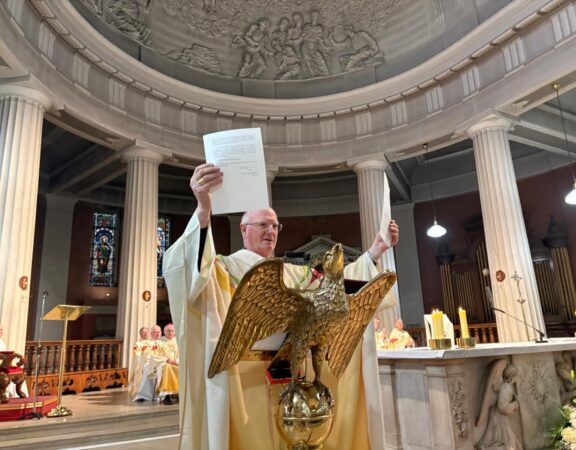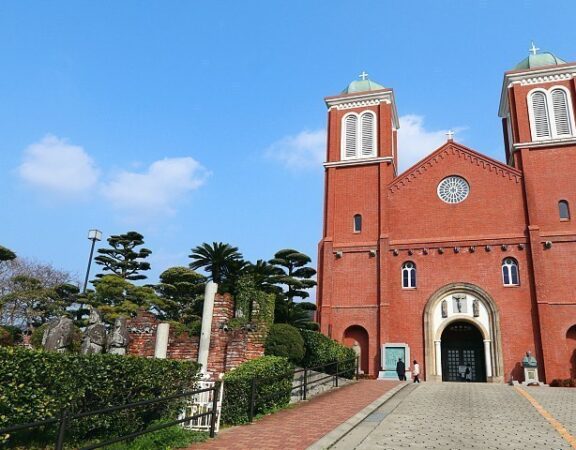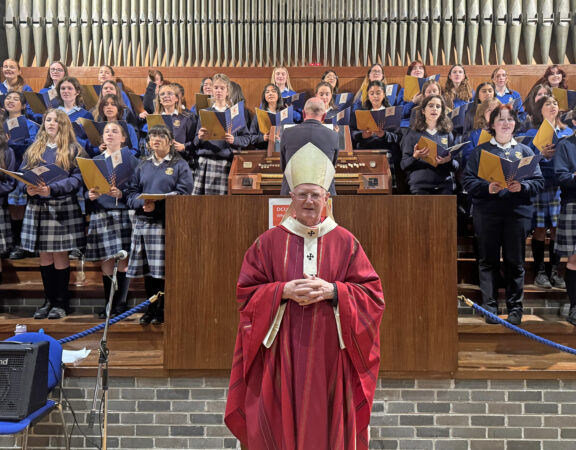Identity and Relevance of the Syro Malabar Diaspora in Catholic Communion
MIGRATION FROM A PASTORAL PERSPECTIVE
Reflection of Most Rev. Diarmuid Martin Archbishop of Dublin
Pontificio Istituto Orientale, Rome, 9 October 2019
“Global migration is a major challenge for today’s world. The care of migrants is a clear priority pastoral concern for Pope Francis. In words and deeds, the Pope repeatedly shows his deep compassion for all who are displaced and are on the move for a variety of reasons.
Pope Francis has established a separate section within the new Dicastery for Promoting Integral Human Development to deal with the question of migrants and refugees and this section is answerable directly to the Pope himself.
Pope Francis has made repeated calls to Catholics and others to welcome, to protect, to promote, and to integrate migrants. Let us look briefly at each of these four dimensions.
Welcoming migrants is both a legal and a cultural phenomenon. Culturally a community has to develop an openness to migrants and help overcome the hostility towards migrants that can emerge and grow in any society. This can be especially the case when there is a belief that immigrants are taking employment or social service benefits away from the local population. This attitude can unfortunately also be something that is deliberately fostered based on false information. Much of the climate that led to the British vote to leave the European Union was based on alarmist and unfounded fear of migrants. Migrants have a right to spiritual and religious assistance according to their traditions. There is a growing problem in Ireland but also in the United Kingdom obtaining entry visa for ministers of religion.
Immigrants must be protected especially in the labour market in order to prevent exploitation and to ensure that they enjoy all the basic rights in the labour market and in working and housing conditions.
Promoting comes through recognising that the encounter of different cultures is a source of mutual enrichment, since inclusion and participation contribute to the development and the stability of societies.
The Integration of migrants is a two-directional process that acknowledges and values the riches of both cultures. Integration does not mean total conformity or renunciation of identity, but it does involve a certain level of alignment and respect for the laws and culture of the host country.
If a Conference like this were to have been held fifteen years ago, then it would have been most unlikely that a representative of the Irish Church would have been invited or if he had been invited, he would have been speaking as representative of a country marked by emigration.
Ireland has changed. Ireland is now a multicultural society, with one in eight residents (12%), about 650,000 in total, born elsewhere, and the demand for skilled and unskilled workers is rising.
12% is a small number compared with other European countries but it marks a radical change in Irish society. Last year almost 90,000 persons immigrated into Ireland. Ireland’s population has reached its highest point in 170 years and could be set to pass the 5m mark as early as next year.
This is the highest point the population has been since the census of 1851, when it was recorded at 5.1m. By the time of the 1861 census, it had dropped to 4.4m because of mass emigration in the decades after the famine of the 1840s.
Religious culture in Ireland has also changed. I want to look at how a recently arrived religious grouping has to find its specific place in this changed culture. In the Archdiocese of Dublin, for example, there are today over 90,000 residents – at the start of the century, the Polish Embassy in Dublin had only 300 Polish citizens registered on its books.
The rise in immigration numbers, along with balanced emigration, will inevitably lead to a continuation of the housing shortage. Pressure on social services is also likely to grow. The Government has to take precautions and foster structures designed to encourage integration and counter racism.
Dublin is a complex European Capital City. Approximately one third of the population of the Republic of Ireland resides in the Archdiocese of Dublin. Dublin is the seat of parliament, of five universities, of the national broadcasting service and of many private broadcasting services, and of the major national newspapers.
Interestingly Dublin is the seat of the European Headquarters of a wide range of leaders in the social media sphere such as Google, PayPal, Microsoft, eBay, LinkedIn and Twitter. Airbnb also has major offices in Dublin. The Irish Data Protection commission is competent for the monitoring of all data protection issues of these companies within the European Union. These companies pay major proportions of their tax in Ireland, attracted by favourable tax rates.
Ireland is changing and the religious culture of Ireland is changing. The Archdiocese of Dublin has a Population of 1,500,000 of whom about 75% would have registered at the national census as Roman Catholic. However at the most recent census, 48% of those between the age of 24 and 29 registered as having no religion. Ireland is economically and culturally a very open society is therefore influenced by a very broad media culture.
Understanding the religious culture of Ireland and its political impact today is not an easy task. Regular religious practice in Ireland has dramatically decreased in recent years but by European standards, religious practice in Ireland is still high. Secularisation is well advanced in Irish society and yet there are many residual elements of faith and religiosity present in daily life.
In Ireland, it has long since moved from being politically risky to get into a battle with the Church, to a situation in which there are few votes to be won through being too closely linked with Church issues. While Ireland remains a predominantly Catholic country, the percentage of the population who identified as Catholic has fallen from 84.2 per cent in 2011 to 78.3 percent in 2016.
Significantly, the number of those who registered as having “no religion” grew by 73.6%, representing almost 10% of the population and is growing. The census showed that Catholicism was the largest religion, followed now by “no religion”, followed then by Anglicanism and in fourth place by Islam.
The “no religion” category was highest in the age group with children entering school life and the group naturally most active in the formation of the political culture of the future. The age group 20-39 accounts for 28 per cent of the general population but 45 per cent of those with no religion fall into this age bracket.
The change in religious culture in Ireland is especially significant in looking at the changing role of marriage and the family in modern Ireland. The basic culture of Ireland is still strongly family-friendly but is changing rapidly. This over all cultural change is likely to intensify. Today the average age of mothers at first births is more than two years younger than the average age at marriage. Today over half of all births outside marriage are to couples who are living together. Same sex marriage was introduced in Ireland by popular vote and by an overwhelming majority. Abortion has been legalised.
The Syro Malabar community in Ireland finds itself therefore as a community with strong religious roots and practice living in a different culture. The Irish Syro Malabar community is recent in its origins. Of the 106 Syro Malabar Qurbana Centres in Europe, 39 are in Ireland. The community in Ireland is a stable one where many families have bought their own houses and are settled in significant employment, especially in the health care and information technology domains. They are now moving into their second generation.
The presence of the Syro Malabar Church is marked by intense pastoral and catechetical activity. In addition to regular Sunday catechesis, there are various ecclesial movements and family units. Outside Dublin Syro-Malabar, priests work primarily in Latin Rite parishes in addition to caring for their own community. In Dublin, the Archdiocese has provided the Syro Malabar community with a pastoral centre, priest’s residence and Church, as well as centres in other parts of the diocese.
There is, however, a special challenge regarding what the integration of the Syro Malabar faithful into the regular Irish religious landscape. They are the largest non-Latin Rite Catholic community, but still a minority. Irish Catholics still find difficulty in recognising the identity of a Church which is not of the Latin Rite and which cannot be integrated directly into the local parish.
In Ireland, the majority of national schools are under the patronage of the Catholic Church and religious instruction and sacramental preparation both take place within a school context. The local Churches find it hard to understand why the children of Syro Malabar Catholics would not simply adapt to Latin Rite traditions in order more easily integrate into the Irish religious cultural tradition. Syro Malabar parents can come under pressure from their own children who want to be fully integrated with their school classmates.
This is not to say that there is hostility towards Syro Malabar Catholics. It is rather a lack of knowledge and understanding. There are also signs of attempts to integrate while maintaining tradition. At Confirmations of their Irish school companions, Syro Malabar children are often given a special place during the liturgy.
There are also challenges regarding the different systems of financial sustenance for the clergy and Church maintenance and administration.
The biggest challenge is of course that of maintaining cultural identity in a growing secularised society, especially for the second generation. Almost all immigrant communities adapt more closely to the culture of the host country within one generation. One of my priests was telling me that he attended a celebration of his neighbouring Syro Malabar community some weeks ago. He was really impressed at the participation of young people and families at the liturgy. He had to leave immediately after the liturgy and was amused as he left to find four teenagers, clearly belonging to the Syro Malabar community, emerging not out of the Church, but out of McDonalds. Young people adapt quickly to the culture of the local community.
A community like the Syro Malabar community in Ireland has to be attentive to those of its community who slip away for various reasons from the practice of their faith. I remember saying to one immigrant chaplain that I was not interested just in those in his community who come regularly to Mass, but also in those who begin to draft away. Once that happens it becomes much harder to reintegrate them.
The presence of the Syro Malabar community in Dublin is clearly an enrichment of the life of the Church. The efforts of regular catechesis of children, the dedication of the priests who reach out to their faithful, the dignity of the liturgies are all things that challenge the Latin Rite Church in Dublin to become a more effective witness to the person and teaching of Jesus Christ in our contemporary society. ENDS







